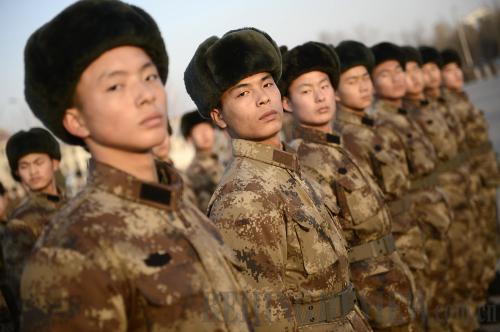|
 |
|
KNOCKED INTO SHAPE: New army recruits stationed in Ningxia Hui Autonomous Region conduct basic training under extremely low temperatures on January 8 (WANG PENG) |
 |
|
The author works for the People's Liberation Army General Staff Headquarters |
Since the beginning of this year, China's military forces have been closely observed by both domestic and foreign news media. The public, too, is intrigued by the new evolution of China's armed forces.
After Xi Jinping took over as chairman of the Communist Party of China Central Military Commission (CMC) last November, he ordered the People's Liberation Army (PLA) to increase its "real combat" awareness. The exact requirement is that the armed forces must "be ready to fight and win battles at all times."
China's military forces have not been engaged in warfare for more than three decades, which greatly challenges its readiness to fight. Whether China's military is a capable fighting force is a major question concerning China's national security, sovereignty, territorial integrity, national dignity and other core interests. Therefore, China's military must remain committed to dismissing any doubt about its capacity to fight and win battles.
Enhanced preparedness
In response to Xi's demands, Fan Changlong and Xu Qiliang, vice chairmen of the CMC, insisted that the PLA should concentrate all of its efforts on building its capacity to win battles.
To achieve this goal, the four general departments of the PLA—the General Staff Headquarters, the General Political Department, the General Logistics Department and the General Armaments Department—have spearheaded a change of work style to be more pragmatic and effective.
When the General Staff Headquarters issued the annual military training instructions, it required the armed forces to increase combat awareness, enhance combat capacity and use actual combat results as evaluation standards. The document calls for more military drills. Later, the General Staff Headquarters announced that the PLA would organize 40 drills in 2013 to enhance capacity to fight real battles.
In February, the four general departments issued a regulation to strengthen the management of spending, demanding that money should be spent on efforts to guarantee victories on the battlefield.
This strategic shift of focusing on winning wars has been integrated into the whole force, the planning and implementation of military drills in particular.
Realistic war games
Since last year, China's military leadership has ordered the addition of more military exercises with operations mimicking real combat.
In order to enhance real combat capacity, the priority is for the PLA to abandon the lax habits brought about by a prolonged period of peace and stability.
Brigades from three branches of the armed forces stationed in the Beijing Military Region conducted an exercise in a training base in Inner Mongolia Autonomous Region in January. A total of 22 weapons and 21 kinds of ammunition were used during this drill, when the temperature dropped to -32 degrees Celsius.
Participating units were criticized during the post-drill review meeting. The armored brigade was condemned for carrying only enough supplies for the drill and the artillery brigade was reprimanded for running out of ammunition at the end of the drill without thinking about "potential enemies" on their way back to camp.
According to a PLA Daily editorial about the drill, the decline of a military often starts with bad habits borne out of a long period of peace. Although peace itself is most welcome, soldiers' laxity is corrosive to combat effectiveness.
British newspaper The Times published a story titled Chinese Soldiers Are Knocked Into Shape Ready for "Real War" on February 16. The report said that China's military is recasting its training toward actual war scenarios, and training exercises have broken with tradition and have begun to throw surprise twists into each situation—sudden, realistic changes to battlefield scenarios that illustrate the kind of threats that China believes it may now face.
| 